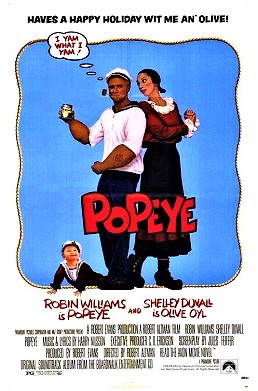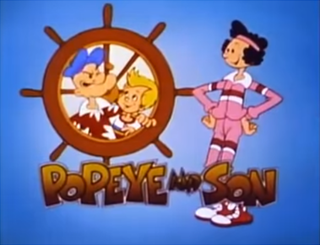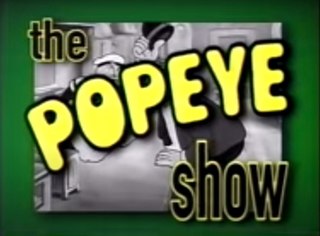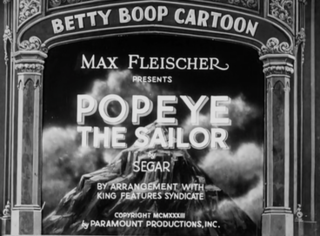
Bluto, at times known as Brutus, is a cartoon and comics character created in 1932 by Elzie Crisler Segar as a one-time character, named "Bluto the Terrible", in his Thimble Theatre comic strip. Bluto made his first appearance on September 12 of that year. Fleischer Studios adapted him the next year (1933) to be the main antagonist of their theatrical Popeye animated cartoon series.

Popeye is a 1980 American musical comedy film directed by Robert Altman and produced by Paramount Pictures and Walt Disney Productions. It is based on E. C. Segar's Popeye comics character. The script was written by Jules Feiffer, and stars Robin Williams as Popeye the Sailor Man and Shelley Duvall as Olive Oyl. Its story follows Popeye's adventures as he arrives in the town of Sweethaven.

Popeye the Sailor Meets Ali Baba's Forty Thieves is a two-reel animated cartoon short subject in the Popeye Color Specials series, produced in Technicolor and released to theatres on November 26, 1937 by Paramount Pictures. It was produced by Max Fleischer for Fleischer Studios, Inc. and directed by Dave Fleischer. Willard Bowsky was head animator, with musical supervision by Sammy Timberg. The voice of Popeye is performed by Jack Mercer, with additional voices by Mae Questel as Olive Oyl, Lou Fleischer as J. Wellington Wimpy and Gus Wickie as Abu Hassan.

Popeye and Son is an American animated comedy series based on the Popeye comic strip created by E.C. Segar and published by King Features Syndicate. Jointly produced by Hanna-Barbera and King Features subsidiary King Features Entertainment, the series aired for one season of thirteen episodes on CBS. It is a follow-up to The All New Popeye Hour. Due to Jack Mercer's death in 1984, Maurice LaMarche voiced Popeye, while much of the cast of The All New Popeye Hour reprised their respective roles, with the exception of Daws Butler. However, Nancy Cartwright, who was trained by Butler, voiced Woody in the series.

The Popeye Show is an American cartoon anthology series that premiered on October 29, 2001, on Cartoon Network. Each episode includes three Popeye theatrical shorts from Fleischer Studios and/or Famous Studios. The show is narrated by Bill Murray, who gives the audience short facts about the history of the cartoons as filler material between each short. Animation historian Jerry Beck served as a consultant and Barry Mills served as writer and producer. A total of 45 episodes were produced, consisting of a total of 135 shorts.
Swee'Pea is a character in E. C. Segar's comic strip Thimble Theatre / Popeye and in the cartoon series derived from it. His name refers to the flower known as the sweet pea. Before his addition to the animated shorts, the name "Sweet Pea" was a term of affection used by main character Popeye. In the cartoon We Aim to Please, he addressed girlfriend Olive Oyl that way.

Buccaneer Bunny is a 1948 Looney Tunes cartoon directed by Friz Freleng. The short was released on May 8, 1948, and features Bugs Bunny and Yosemite Sam.

Popeye the Sailor is a 1933 animated short produced by Fleischer Studios and distributed by Paramount Publix Corporation. While billed as a Betty Boop cartoon, it was produced as a vehicle for Popeye in his debut animated appearance.

I Yam What I Yam is the second Popeye theatrical cartoon short, starring William "Billy" Costello as Popeye, Bonnie Poe as Olive Oyl and Charles Lawrence as Wimpy. The source of the quote is the comic strip, Thimble Theatre by E. C. Segar, in which Popeye first appeared. This is a paraphrase of words spoken by Popeye in the comic strip.
Samuel Lerner was a Romanian-born songwriter for American and British musical theatre and film.
This is a list of the 122 cartoons of the Popeye the Sailor film series produced by Famous Studios for Paramount Pictures from 1942 to 1957, with 14 in black-and-white and 108 in color. These cartoons were produced after Paramount took ownership of Fleischer Studios, which originated the Popeye series in 1933.

Popeye the Sailor is an American animated television series produced for King Features Syndicate TV starring Popeye that was released between 1960 and 1963 with 220 episodes produced. The episodes were produced by a variety of production studios and aired in broadcast syndication until the 1990s.

Popeye the Sailor is an American animated series of short films based on the Popeye comic strip character created by E. C. Segar. In 1933, Max and Dave Fleischer's Fleischer Studios, based in New York City, adapted Segar's characters into a series of theatrical cartoon shorts for Paramount Pictures. The plotlines in the animated cartoons tended to be simpler than those presented in the comic strips, and the characters slightly different. A villain, usually Bluto, makes a move on Popeye's "sweetie", Olive Oyl. The villain clobbers Popeye until he eats spinach, giving him superhuman strength. Thus empowered, Popeye makes short work of the villain.
Popeye Meets the Man Who Hated Laughter, also known as The Man Who Hated Laughter, is a 1972 American animated one-hour television special that was part of The ABC Saturday Superstar Movie. This film united characters from almost every newspaper comic strip then owned by King Features Syndicate in one story. The show aired on October 7, 1972, and was repeated in February 1974.

Popeye the Sailor is a fictional cartoon character created by Elzie Crisler Segar. The character first appeared on January 17, 1929, in the daily King Features comic strip Thimble Theatre. The strip was in its tenth year when Popeye made his debut, but the one-eyed sailor quickly became the lead character, and Thimble Theatre became one of King Features' most popular properties during the 1930s. Following Segar's death in 1938, Thimble Theatre was continued by several writers and artists, most notably Segar's assistant Bud Sagendorf. The strip continues to appear in first-run installments on Sundays, written and drawn by R. K. Milholland. The daily strips are reprints of old Sagendorf stories.

Blow me Down! is a Popeye theatrical cartoon short in the Paramount Picture short series. It was released in 1933 and was the third cartoon in the Popeye the Sailor series of theatrical cartoons released by Paramount Pictures.

Let's You and Him Fight is a Popeye theatrical cartoon short released in February 16, 1934, starring William "Billy" Costello as Popeye, Bonnie Poe as Olive Oyl, William Pennell as Bluto and Charles Lawrence as the announcer.

Spinach Fer Britain is a 1943 anti-Nazi propaganda cartoon, produced by Famous Studios and distributed by Paramount Pictures. The film centers around Popeye the Sailor trying to deliver a shipment of spinach to 10 Downing Street in London, while fighting off Nazi Kriegsmarine soldiers pursuing him in a U-boat. The short was released on January 22, 1943.

Scrap the Japs is a 1942 American anti-Japanese cartoon with the popular character Popeye as protagonist. It follows his adventures after being sent for punishment on a ship and running into Japanese sailors.
Pop-Pie a la Mode is a 1945 Popeye theatrical cartoon short, starring Jack Mercer as Popeye. Produced by Famous Studios and directed by Isadore Sparber, it was the 132nd cartoon in the Popeye series of theatrical cartoons released by Paramount Pictures.















